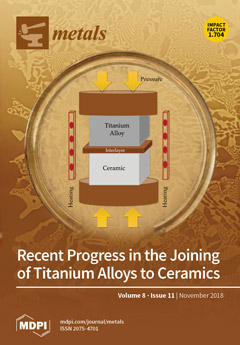High-entropy alloys exhibit some interesting mechanical properties including an excellent resistance against softening at elevated temperatures. This gives high-entropy alloys (HEAs) great potential as new structural materials for high-temperature applications. In a previous study of the authors, oxidation behavior of Al
0.6CrFeCoNi
[...] Read more.
High-entropy alloys exhibit some interesting mechanical properties including an excellent resistance against softening at elevated temperatures. This gives high-entropy alloys (HEAs) great potential as new structural materials for high-temperature applications. In a previous study of the authors, oxidation behavior of Al
0.6CrFeCoNi and Al
0.6CrFeCoNiSi
0.3 high-entropy alloys at T = 800 °C, 900 °C and 1000 °C was investigated. Si-alloying was found to increase the oxidation resistance by promoting the formation of a continuous Al
2O
3 layer, avoiding the formation of AlN at T = 800 °C. Obvious phase changes were identified in the surface areas of both alloys after the oxidation experiments. However, the effects of heat treatment and Si-alloying on the phase transition in the bulk were not investigated yet. In this study, Al
0.6CrFeCoNi and Al
0.6CrFeCoNiSi
0.3 high-entropy alloys were heat-treated at T = 800 °C and T = 1000 °C to investigate the effect of heat treatment on microstructure, phase composition and mechanical properties of both alloys. The results show that alloying Al
0.6CrFeCoNi with Si caused a phase transition from dual phases consisting of BCC and FCC to a single BCC phase in an as-cast condition. Furthermore, increased hardness for as-cast and heat-treated samples compared with the Al
0.6CrFeCoNi alloy was observed. In addition, the heat treatment facilitated the phase transition and the precipitation of the intermetallic phase, which resulted in the change of the mechanical properties of the alloys.
Full article





